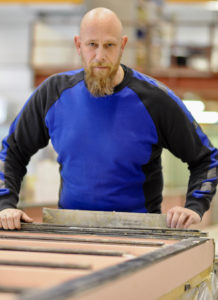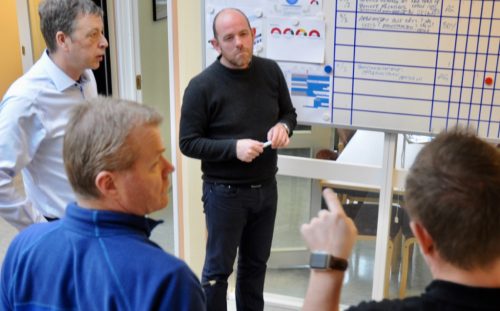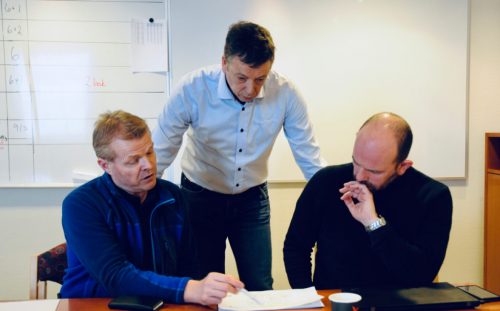-General manager Martin Henøen in Bussbygg
The traditional industrial company is located in Skåla outside Molde and became a pilot company in the Productivity Leap in the autumn of 2018. Bussbygg started as a manufacturer of buses, but later switched to cabinets and superstructures for trucks and trailers. The factory is today the largest of its kind in Norway and produces cabinets in a large number of varieties. The company employs 120 people.
When we visit Bussbygg, they are in the middle of completing an intensive course in TPM (Total Productive Maintenance), where Haythem Nam from C2U Group takes the management team and the improvement team through a workshop with introduction and focused practical training in systematic maintenance work.
It is a workshop Bussbygg has chosen as an option within the Productivity Leap. The background is a period where a breakdown and stoppage of one of the very central production machines has been a challenge.
-We do not have many large machines in our production, but the CNC machine is very critical and requires a lot of inspection. When we have problems with it, we have to do something quickly, says Henøen.
Selects specialization
The participants in the Productivity Leap can choose to specialize in theoretical and practical training based on their own needs. Precisely this is one of the great advantages of the program, Henøen believes. Together with product manager and Lean coordinator André Gussiås, he follows up the daily work with the program.
When Bussbygg in the spring of 2018 received the offer to be a pilot company in the Productivity Leap, they had already made the decision to focus on continuous improvement with the Lean methodology. They had participated in the program Proff 2017 with Kiwa and seen that the way of working suited them well. At the same time, they had started a new production process for the production of cabinets. It was a good idea to immerse yourself more in the material. With the introduction from Proff behind them, they quickly got started with the specialization.
Requires a lot
In an industry with great competition and small margins, one is dependent on mastering continuous improvement. Although Bussbygg is the largest in Norway, they will be small in a European context. The company has delivered positive results for many years, but it is not a matter of course that the development will continue in the same way. One must invest consciously to maintain and preferably improve the position in the market.
-What experiences do you have with the Productivity Leap so far?
– We have already received positive results after we focused on flow in production. The lead time has decreased considerably since we started this project. So far we have worked a lot with the overall and have not drawn conclusions with regard to productivity improvements, but we will not hide that the project requires a lot, says André Gussiås.
-As a small company, we do not have the opportunity to invest extra resources, but must staff both the improvement team and the steering group with employees who have their regular tasks in daily operations. To succeed with the Productivity Leap, one must set aside time and be prepared for a significant personal effort. I think it is important to be aware of this when applying to participate, he continues.Some clear improvements are still easy to point out after a short year in the project:-We have taken a long step further in mastering visual control and have got the Lean board in order. We update the status continuously and are up to date for the heart rate meeting every day at 11.07.
Better internal communication
It also contributes to the improvement of internal communication. We have consensus in the organization, a better overview and better insight into where each department stands. We have worked a lot with achieving consensus in the steering group for the project. During the 11-week introductory period, this was an important issue. When we started, we quickly saw that the organization was sub-optimized. Employees in each department had an overview of their tasks, but not the whole. The situation today is completely different, says Henøen.
-Do you say that you have created a change in the corporate culture already?
– We are well underway. When we launched the Productivity Leap with us, we conducted a survey among all employees. The results indicate that everyone has understood what the initiative is about and joins the purpose. There will always be critical voices, but we experience no opposition or objections to the improvement work. We must always expect to meet some skepticism. This will change when we move forward with training of more employees, says Gussiås.
-Have you set specific goals for the improvement work?
-Yes, we have established KPIs such as reduced lead time, increased share of ”straight from me” and ”Right from subcontractor” (delivery precision), he says and continues:
-We already have a detectable reduced lead time in normal situations, ie when we do not produce particularly complicated buildings and when we do not have accidents.
The framework was in place
Bussbygg had the framework for continuous improvement in place before they entered the Productivity Leap. Meeting structure, boards and 5S were established.
General manager Martin Henøen emphasizes that the improvement work has been significantly intensified with the Productivity Leap. It provides a whole and better opportunity to work according to the same vision and towards common goals.
-Before the productivity leap, we could experience that goals for continuous improvement were a topic only for the production departments, now we involve all departments. For example, we recently worked two days on an improvement theme in the marketing department. In this way, we will also continue to involve more departments. If the production changes methodology while other departments continue in the same way as before, we will not achieve the changes we have set ourselves as a goal, he says.
-What about the involvement of top management?
-The improvement work can not be delegated, here the top management must be involved at all times. With us, the management team participates every day in the improvement work both in meetings and practical follow-up, says Henøen.
Worth the effort
The two leaders look forward to the entire organization being confident in the methodology for continuous improvement. In September this year, they will start phase 2 of the Productivity Leap. They see that it will require increased investment in building their own competence, but through the program they get both good process support, coaching and training.
-As managers, we must constantly take care so that challenges that arise in the daily operations do not take precedence and event-based problem solving must be at the expense of systematic continuous improvement. With the Productivity Leap, we have definitely got on the right track, the two say.



